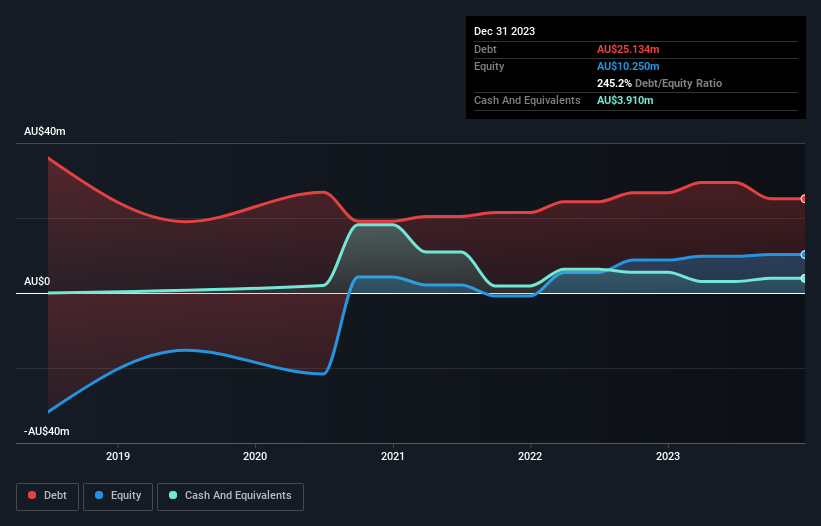Howard Marks put it nicely when he said that, rather than worrying about share price volatility, 'The possibility of permanent loss is the risk I worry about... and every practical investor I know worries about.' It's only natural to consider a company's balance sheet when you examine how risky it is, since debt is often involved when a business collapses. We can see that WA Kaolin Limited (ASX:WAK) does use debt in its business. But should shareholders be worried about its use of debt?
Why Does Debt Bring Risk?
Generally speaking, debt only becomes a real problem when a company can't easily pay it off, either by raising capital or with its own cash flow. In the worst case scenario, a company can go bankrupt if it cannot pay its creditors. However, a more frequent (but still costly) occurrence is where a company must issue shares at bargain-basement prices, permanently diluting shareholders, just to shore up its balance sheet. By replacing dilution, though, debt can be an extremely good tool for businesses that need capital to invest in growth at high rates of return. The first step when considering a company's debt levels is to consider its cash and debt together.
View our latest analysis for WA Kaolin
What Is WA Kaolin's Net Debt?
As you can see below, WA Kaolin had AU$25.1m of debt at December 2023, down from AU$26.7m a year prior. However, it does have AU$3.91m in cash offsetting this, leading to net debt of about AU$21.2m.

A Look At WA Kaolin's Liabilities
According to the last reported balance sheet, WA Kaolin had liabilities of AU$24.5m due within 12 months, and liabilities of AU$4.88m due beyond 12 months. On the other hand, it had cash of AU$3.91m and AU$603.6k worth of receivables due within a year. So its liabilities outweigh the sum of its cash and (near-term) receivables by AU$24.8m.
This is a mountain of leverage relative to its market capitalization of AU$29.2m. Should its lenders demand that it shore up the balance sheet, shareholders would likely face severe dilution. When analysing debt levels, the balance sheet is the obvious place to start. But you can't view debt in total isolation; since WA Kaolin will need earnings to service that debt. So when considering debt, it's definitely worth looking at the earnings trend. Click here for an interactive snapshot.
In the last year WA Kaolin wasn't profitable at an EBIT level, but managed to grow its revenue by 16%, to AU$1.8m. We usually like to see faster growth from unprofitable companies, but each to their own.
Caveat Emptor
Importantly, WA Kaolin had an earnings before interest and tax (EBIT) loss over the last year. Its EBIT loss was a whopping AU$4.5m. When we look at that and recall the liabilities on its balance sheet, relative to cash, it seems unwise to us for the company to have any debt. So we think its balance sheet is a little strained, though not beyond repair. Another cause for caution is that is bled AU$12m in negative free cash flow over the last twelve months. So suffice it to say we consider the stock very risky. The balance sheet is clearly the area to focus on when you are analysing debt. However, not all investment risk resides within the balance sheet - far from it. To that end, you should learn about the 4 warning signs we've spotted with WA Kaolin (including 1 which is a bit concerning) .
At the end of the day, it's often better to focus on companies that are free from net debt. You can access our special list of such companies (all with a track record of profit growth). It's free.
Valuation is complex, but we're here to simplify it.
Discover if WA Kaolin might be undervalued or overvalued with our detailed analysis, featuring fair value estimates, potential risks, dividends, insider trades, and its financial condition.
Access Free AnalysisHave feedback on this article? Concerned about the content? Get in touch with us directly. Alternatively, email editorial-team (at) simplywallst.com.
This article by Simply Wall St is general in nature. We provide commentary based on historical data and analyst forecasts only using an unbiased methodology and our articles are not intended to be financial advice. It does not constitute a recommendation to buy or sell any stock, and does not take account of your objectives, or your financial situation. We aim to bring you long-term focused analysis driven by fundamental data. Note that our analysis may not factor in the latest price-sensitive company announcements or qualitative material. Simply Wall St has no position in any stocks mentioned.
About ASX:WAK
WA Kaolin
Explores and develops a mineral resource of kaolinized granite in Australia.
Slight risk and slightly overvalued.
Similar Companies
Market Insights
Community Narratives



